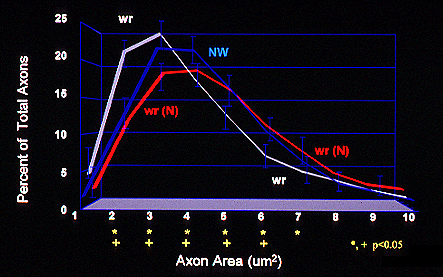 Reduction of lower motor neuron degeneration in wobbler mice by N-acetylcysteine
Reduction of lower motor neuron degeneration in wobbler mice by N-acetylcysteine Reduction of lower motor neuron degeneration in wobbler mice by N-acetylcysteine
Reduction of lower motor neuron degeneration in wobbler mice by N-acetylcysteineJeffrey T. Henderson, Mohammed Javaheri, Susan Kopko and John C. Roder
Samuel Lunenfeld Research Institute, Mount Sinai
Hospital,
Program in Molecular Biology and Cancer, 600
University Ave., Toronto, Ontario M5G-1X5
Figure 2.NAC prevents losses in axon caliber within the medial facial nerve of wobbler mice.
 A: Comparison of axon calibers of the facial
nerve of NW and wr/wr(N) treatment groups.
at 9 weeks of age, n=6 animals per group. Note the similarity of the axon calibers of the wr/wr(N) (NAC-treated) to NW (non-wobbler) controls.
A: Comparison of axon calibers of the facial
nerve of NW and wr/wr(N) treatment groups.
at 9 weeks of age, n=6 animals per group. Note the similarity of the axon calibers of the wr/wr(N) (NAC-treated) to NW (non-wobbler) controls.
 B: Comparison of the axon calibers of the
facial nerve of wr/wr and wr/wr(N) treatment groups at 9 weeks of age, n=6 animals per group. Note the marked reduction
in small (atrophic) axon calibers in wr/wr animals treated with NAC as compared (L-alanine treated) wr/wr mice.
B: Comparison of the axon calibers of the
facial nerve of wr/wr and wr/wr(N) treatment groups at 9 weeks of age, n=6 animals per group. Note the marked reduction
in small (atrophic) axon calibers in wr/wr animals treated with NAC as compared (L-alanine treated) wr/wr mice.
 C: Summary of axon distributions from wr/wr, wr/wr(N), and NW treatment groups. Note
that treatment with N-acetyl cysteine results in an increase in the distribution of wr/wr axon calibers to NW levels. For all groups n=6; Values represent the mean + S.E.M., (*) signifies a significant difference (p<0.05) between wr/wr(N) and wr/wr groups at the indicated axon area. (+) signifies a significant difference between NW and wr/wr groups at the indicated axon area. Within a given group, individual percent values did not vary by more than + 2% of the mean.
C: Summary of axon distributions from wr/wr, wr/wr(N), and NW treatment groups. Note
that treatment with N-acetyl cysteine results in an increase in the distribution of wr/wr axon calibers to NW levels. For all groups n=6; Values represent the mean + S.E.M., (*) signifies a significant difference (p<0.05) between wr/wr(N) and wr/wr groups at the indicated axon area. (+) signifies a significant difference between NW and wr/wr groups at the indicated axon area. Within a given group, individual percent values did not vary by more than + 2% of the mean.